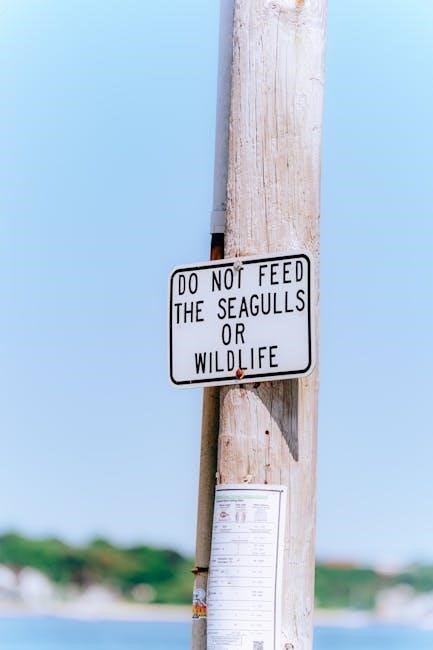collision regulation pdf

The COLREG Consolidated 2018 PDF provides a comprehensive guide to the International Regulations for Preventing Collisions at Sea. It includes rules on lights, shapes, sound signals, and safe navigation practices, ensuring maritime safety globally. This essential document, standardized by the IMO, is a must-have for all maritime professionals;
Overview of Collision Regulations
The International Regulations for Preventing Collisions at Sea (COLREGs) are a set of rules designed to promote maritime safety by preventing collisions between vessels. These regulations apply to all ships, regardless of their size or type, and cover key aspects such as the use of lights, shapes, and sound signals. The rules are divided into general provisions and specific conduct requirements, ensuring clarity and consistency in navigation. Compliance with COLREGs is mandatory for all vessels and is enforced internationally to maintain safe maritime practices and reduce the risk of accidents at sea.
Importance of COLREGs in Maritime Safety
The COLREGs are a cornerstone of maritime safety, providing standardized rules to prevent collisions at sea. By ensuring uniform practices globally, they minimize risks and enhance safety for all vessels. Compliance with COLREGs is mandatory, reducing confusion and accidents. These regulations protect lives, cargo, and the environment by promoting responsible navigation. Their adherence is critical for maintaining order in busy waterways and ensuring the integrity of international maritime operations. Non-compliance can lead to severe legal consequences, underscoring the importance of strict adherence to these vital safety standards.
Structure of the Collision Regulation PDF
The Collision Regulation PDF is a well-organized document divided into six main parts, ensuring clarity and ease of reference. It begins with general provisions, outlining the application and responsibilities of vessels. The subsequent sections detail rules for vessel conduct, including traffic separation schemes, head-on situations, and actions to avoid collisions. Technical requirements for lights, shapes, and sound signals are thoroughly covered, with specific intensity and visibility standards. Special provisions and exemptions are also addressed, alongside compliance and enforcement mechanisms. Annexes provide additional details, making the PDF a comprehensive resource for maritime safety.

Historical Background of COLREGs
The COLREGs were established in 1972 by the International Maritime Organization (IMO) to standardize maritime safety rules globally, preventing collisions at sea and ensuring safe navigation practices.
Development of International Maritime Regulations
The development of COLREGs began with the need for standardized maritime safety rules. The International Maritime Organization (IMO) established the first comprehensive regulations in 1972, which were later updated in 2018. These rules, known as COLREG Consolidated 2018, provide detailed guidelines for preventing collisions at sea, covering lights, shapes, sound signals, and right-of-way rules. The development process involved international collaboration to ensure uniformity in maritime practices. The IMO continues to update these regulations to address new challenges and technologies, ensuring safer navigation for all vessels globally.
Key Milestones in COLREGs History
The development of COLREGs has been marked by significant milestones. The first international convention was adopted in 1960, laying the groundwork for standardized collision prevention rules. The 1972 Convention on the International Regulations for Preventing Collisions at Sea introduced comprehensive updates, which became effective in 1977. In 2018, the COLREG Consolidated Edition was released, incorporating all amendments and providing a unified reference for maritime safety. These milestones reflect the evolution of maritime law and the global commitment to preventing collisions at sea, ensuring safer navigation for all vessels.
Evolution of Collision Prevention Rules
The collision prevention rules have evolved significantly to address advancing maritime technologies and safety needs. Originally established in 1960, the rules were comprehensively updated in 1972 to standardize international practices. The 2018 COLREG Consolidated Edition integrated all amendments, providing clarity and consistency. These updates reflect adaptations to modern navigation challenges, ensuring rules remain effective in preventing collisions. Continuous revisions underscore the importance of aligning regulations with technological advancements and operational realities, safeguarding maritime safety globally. This evolution demonstrates a commitment to proactive collision prevention in an ever-changing maritime environment.

General Provisions of COLREGs
The COLREGs establish fundamental principles for maritime safety, applying to all vessels on the high seas and navigable waters. They outline responsibilities, obligations, and essential standards for collision prevention, ensuring uniform global compliance and safe navigation practices.
Application of the Regulations
The COLREGs apply universally to all vessels on the high seas and navigable waters, ensuring standardized maritime safety practices globally. They are binding for ships of all sizes and types, with specific provisions addressing unique operational needs. The regulations are enforced through international agreements, with the IMO overseeing their implementation. While primarily focused on collision prevention, they also address navigation rights and responsibilities. Exceptions exist for certain vessels, such as those in distress, but adherence is mandatory in most cases. Compliance ensures harmonized safety standards worldwide, adapting to technological advancements while maintaining core principles of safe navigation.
Responsibilities of Vessels and Crews
Vessels and their crews must comply with COLREGs to ensure safe navigation and prevent collisions; This includes proper use of lights, shapes, and sound signals to maintain visibility and communication. Crews are responsible for continuous vigilance, monitoring navigation equipment, and adhering to traffic separation schemes. They must take evasive action when necessary and document all incidents. Compliance with these regulations is essential for upholding maritime safety standards and preventing accidents at sea.
General Obligations Under COLREGs
The COLREGs establish fundamental obligations for all vessels to ensure safe navigation and collision prevention. These include maintaining a safe speed, using lights and shapes correctly, and employing sound signals as specified. Vessels must take all necessary actions to avoid collisions, even if other ships fail to comply with the regulations. The rules apply universally to all ships on the high seas and navigable waters, emphasizing mutual responsibility and adherence to standardized practices. Compliance with these obligations is enforced by the International Maritime Organization (IMO) to uphold global maritime safety standards.

Specific Rules for Vessel Conduct
The COLREGs outline specific rules governing vessel behavior, including traffic separation schemes, head-on situations, and risk of collision scenarios, ensuring safe maritime navigation practices globally.
Rule 10: Traffic Separation Schemes
Rule 10 of the COLREGs governs vessel behavior in or near traffic separation schemes, which are designed to reduce collision risks by separating opposing traffic flows. Vessels must comply with these schemes, as mandated by SOLAS regulation V/8, recognizing IMO as the sole authority for international ship routing. The rule ensures safe navigation by requiring vessels to stay within designated lanes and avoid crossing traffic separation zones unnecessarily, thereby minimizing the risk of collisions in busy shipping areas. Proper adherence to Rule 10 is crucial for maintaining maritime safety and efficient traffic flow at sea.
Rule 14: Head-On Situation
Rule 14 of the COLREGs addresses the conduct of power-driven vessels in a head-on situation. When two such vessels are approaching each other, both must alter their course to starboard to avoid collision. This rule ensures predictable action, reducing the risk of accidents; The action should be taken in ample time, with each vessel maintaining a safe distance. The rule applies to all power-driven vessels, emphasizing the importance of mutual cooperation and adherence to standardized procedures to ensure maritime safety in such scenarios.
Rule 7: Risk of Collision
Rule 7 of the COLREGs outlines the procedures for determining the risk of collision between vessels. It mandates that a thorough assessment of the situation be conducted, considering factors such as the bearing and range of other vessels. The rule applies to all vessels, regardless of their type or size. If a risk of collision is detected, early and substantial action must be taken to avoid it. This rule emphasizes the importance of vigilance and proactive measures to ensure maritime safety and prevent potential collisions at sea.
Rule 8: Action to Avoid Collision
Rule 8 of the COLREGs dictates the actions to be taken when a risk of collision is identified. It requires that any action to avoid collision must be substantial and noticeable, ensuring it effectively alters the situation. The rule emphasizes that actions should comply with the Regulations and be clear to avoid confusion. Both the overtaking and overtaken vessels have specific responsibilities to take appropriate measures. The effectiveness of the action must be continuously monitored to ensure the risk of collision is mitigated. This rule underscores the importance of decisive and coordinated actions to maintain maritime safety.

Technical Requirements for Vessels
The COLREGs outline specific technical requirements for vessels, including lights, shapes, and sound signals, to ensure visibility and compliance, enhancing maritime safety and collision prevention.
Lights and Shapes: Requirements and Specifications
The COLREGs mandate specific requirements for lights and shapes to ensure vessel visibility and clear communication. Vessels must display masthead lights, stern lights, and shapes such as balls or cones to indicate their status and intentions. The intensity and visibility of these lights are precisely specified to ensure they are discernible under various conditions. Compliance with these standards is critical for safe navigation, particularly at night or in low-visibility situations, aiding in collision prevention and adherence to maritime regulations. Proper installation and maintenance of these visual aids are essential for effective communication between vessels.
Sound Signals: Types and Usage
COLREGs specify sound signals as a critical means of communication between vessels. Whistles, bells, and gongs are the primary types, with their use varying by vessel size and situation. Sound signals convey intentions, such as changing course or reducing speed, and are especially vital in low visibility. The number, duration, and sequence of blasts or rings indicate specific actions, ensuring clarity in navigation decisions. Compliance with these auditory rules enhances safety, particularly in fog or darkness, by providing audible warnings and facilitating collision prevention in accordance with international maritime standards.
Visibility and Intensity of Lights
COLREGs specify the visibility and intensity requirements for navigation lights to ensure they are visible at prescribed distances. The regulations mandate that lights must be capable of being seen at specific angles and ranges, depending on their type and purpose. Factors such as color, mounting height, and power output are standardized to ensure consistency. Proper visibility and intensity of lights are critical for effective communication and collision prevention, particularly in low-light conditions. Compliance with these specifications is essential for maintaining maritime safety and adhering to international standards.

Special Provisions and Exemptions
The COLREGs include exemptions for specific vessel types, provisions for ships in distress, and special cases within traffic separation schemes to accommodate unique operational needs.
Exemptions for Specific Vessel Types
Certain vessels, such as those with limited maneuverability or historic ships, may be exempt from specific COLREG requirements. These exemptions are outlined to accommodate unique operational needs while maintaining safety. For instance, vessels restricted in their ability to deviate from their course due to draft or other constraints may receive special considerations. Additionally, exemptions may apply to ships engaged in fishing or scientific research under specific conditions. The regulations ensure that such exemptions do not compromise overall maritime safety but allow for practical flexibility in certain circumstances.
Provisions for Vessels in Distress
The COLREGs include specific provisions for vessels in distress, ensuring their safety while minimizing risks to others. Vessels in distress may be exempt from certain rules to prioritize survival. These provisions emphasize the use of distress signals to alert nearby vessels. Ships must take necessary precautions to avoid collisions while assisting distressed vessels. The regulations also outline responsibilities for other vessels to provide aid when possible, balancing safety with humanitarian obligations; These measures ensure that distress situations are handled with both urgency and adherence to maritime safety standards.
Special Cases in Traffic Separation Schemes
Traffic separation schemes (TSS) are critical for reducing collision risks in busy maritime routes. Special cases arise when vessels must navigate through these schemes due to operational constraints. These include vessels with limited maneuverability, such as those engaged in fishing or underwater operations. The COLREGs provide exemptions for such vessels, allowing them to deviate from standard rules under specific conditions. Additionally, vessels crossing TSS must do so at right angles to minimize disruption. These provisions ensure safe and efficient navigation while addressing unique operational needs. Compliance with TSS rules is essential for maintaining maritime safety.

Compliance and Enforcement
Compliance with COLREGs is enforced globally by the IMO, ensuring maritime safety through standardized rules and legal frameworks. Non-compliance results in penalties, emphasizing the importance of adherence to these regulations.
Role of the International Maritime Organization (IMO)
The International Maritime Organization (IMO) plays a pivotal role in developing and enforcing COLREGs, serving as the primary authority for global maritime safety. Recognized as the sole competent organization for international ship routing measures, IMO ensures uniformity in collision prevention rules. It updates regulations to address emerging challenges, promotes compliance through legal frameworks, and provides guidelines for safe navigation practices. IMO’s efforts are crucial in maintaining maritime safety and preventing collisions at sea, ensuring all vessels adhere to standardized rules for global maritime harmony and risk mitigation.
Legal Framework for COLREGs
The legal framework for COLREGs is established under the 1972 Convention on the International Regulations for Preventing Collisions at Sea. These rules are legally binding and apply to all vessels on the high seas and navigable waters. The framework ensures uniformity in maritime safety standards globally. Non-compliance with COLREGs can result in legal consequences, including penalties and liability for damages. The IMO enforces these regulations through international agreements, making them a cornerstone of modern maritime law and essential for preventing collisions at sea.
Consequences of Non-Compliance
Non-compliance with COLREGs can lead to severe legal penalties, including fines and liability for damages. Vessels found violating the regulations may face detention or inspections by port authorities. Additionally, non-compliance increases the risk of collisions, endangering lives, and causing environmental damage. Insurance costs may rise for non-compliant vessels, and reputational damage can harm maritime businesses; Regulatory bodies, such as the IMO, enforce these rules to ensure maritime safety and prevent such consequences. Adherence to COLREGs is critical to maintaining safe and efficient global maritime operations.

Practical Applications of COLREGs
The COLREGs are essential for safe navigation, providing clear guidelines on lights, shapes, and sound signals. They aid in training maritime professionals and preventing collisions at sea.
Case Studies: Avoiding Collisions at Sea
Real-world examples demonstrate how COLREGs prevent maritime collisions. A notable case involved a head-on situation where Rule 14 guided vessels to alter course safely. Another instance highlighted the effectiveness of Rule 10 in navigating traffic separation schemes without incident. These scenarios underscore the practical importance of adhering to COLREGs, ensuring safe navigation and preventing potential disasters at sea.
- A head-on situation resolved by Rule 14 guidelines.
- Successful navigation through traffic separation schemes under Rule 10.
Best Practices for Safe Navigation
Adhering to COLREGs is crucial for safe navigation. Vessels should maintain a lookout, use radar, and follow traffic separation schemes. Proper display of lights and shapes ensures visibility. Sound signals are vital in low visibility. Skippers must assess risks and take early action to avoid collisions. Continuous training and familiarity with COLREGs enhance compliance. Regular drills and updating safety equipment are recommended. By following these practices, mariners can minimize collision risks and ensure safe maritime operations. The COLREG Consolidated 2018 PDF serves as a key resource for these guidelines.
- Maintain constant vigilance and use radar.
- Follow traffic separation schemes under Rule 10.
- Ensure proper display of lights and shapes.
- Use sound signals in low visibility.
Training and Certification in COLREGs
Training and certification in COLREGs are essential for maritime professionals to ensure compliance and safe navigation. The COLREG Consolidated 2018 PDF serves as a primary resource for studying these regulations. Maritime training institutions offer courses that cover the rules, with a focus on practical application. Certifications are often required for crew members and officers, ensuring they understand and can implement collision prevention measures. Regular updates and refresher courses help mariners stay informed about the latest amendments and best practices, reinforcing their ability to navigate safely and avoid collisions at sea.
- Comprehensive courses on COLREGs rules and amendments.
- Practical exercises to apply collision prevention measures.
- Certifications required for crew members and officers.
- Refresher courses to stay updated on maritime safety standards.

Future of Collision Regulations
The future of collision regulations will likely involve advancements in maritime safety technologies, such as autonomous systems and enhanced monitoring tools, to further reduce collision risks at sea.
Advancements in Maritime Safety Technologies
Advancements in maritime safety technologies are revolutionizing collision prevention, with innovations like autonomous systems, enhanced collision avoidance systems, and improved monitoring tools. These technologies integrate with existing COLREGs to enhance compliance and reduce risks. For instance, advanced sensor technologies and AI-driven navigation systems provide real-time data, enabling vessels to make safer decisions. Additionally, the development of autonomous vessels and predictive analytics is expected to further mitigate collision risks. Such innovations ensure that maritime safety remains aligned with technological progress, fostering a safer and more efficient maritime environment globally.
Proposed Updates to COLREGs
Proposed updates to COLREGs aim to enhance maritime safety and efficiency in response to evolving technologies and operational needs. Recent amendments include the mandatory use of Electronic Chart Display and Information Systems (ECDIS) and enhanced guidelines for cyber safety in navigation systems. Additionally, updates address the integration of autonomous vessels into existing collision prevention frameworks. These changes reflect the IMO’s commitment to adapting COLREGs to modern challenges, ensuring they remain effective in preventing collisions and promoting safe maritime practices globally.
Challenges in Modern Maritime Safety
Modern maritime safety faces challenges such as the rise of autonomous vessels, which require updated collision prevention protocols. Space debris adds risks, as recent satellite collisions highlight the need for better international regulations. Additionally, cybersecurity threats to navigation systems pose significant dangers. The increasing complexity of global shipping lanes also raises concerns about congestion and accidents. Addressing these issues demands continuous updates to COLREGs and the adoption of advanced technologies to ensure safer maritime operations and mitigate emerging risks effectively.
The Collision Regulation PDF is an essential resource for maritime safety, emphasizing adherence to COLREGs for safe navigation and collision prevention, ensuring continuous learning and compliance.
The COLREG Consolidated 2018 PDF outlines essential maritime safety rules, emphasizing vessel conduct, lights, shapes, and sound signals. It ensures safe navigation and collision prevention globally. The document, standardized by the IMO, applies to all vessels, with specific provisions for traffic separation schemes and distress situations. Compliance with these regulations is crucial for maritime safety and legal adherence. Continuous learning and updates are vital for staying informed about the latest advancements and amendments. The PDF serves as a comprehensive reference for maritime professionals, ensuring adherence to international standards and promoting safe sea navigation practices worldwide.
Final Thoughts on Collision Prevention
Adhering to the COLREGs is critical for ensuring maritime safety and preventing collisions. The regulations provide a clear framework for vessel conduct, emphasizing vigilance, proper signaling, and proactive decision-making. By understanding and applying these rules, mariners can significantly reduce collision risks. Continuous learning and staying updated on amendments are essential for safe navigation. The COLREG Consolidated 2018 PDF serves as a vital resource, offering comprehensive guidance for all maritime professionals. Its principles are fundamental to fostering a safer and more efficient global maritime environment.
Importance of Continuous Learning
Continuous learning is vital for mariners to stay updated on the latest COLREGs and maritime safety practices. The dynamic nature of maritime operations demands ongoing education to adapt to new technologies and regulatory updates. Staying informed ensures mariners can apply the rules effectively in real-life scenarios, reducing collision risks. The COLREG Consolidated 2018 PDF and related resources provide essential guidance, while training programs reinforce practical application. Commitment to lifelong learning fosters a culture of safety, enabling mariners to navigate confidently and responsibly in an ever-evolving maritime environment.

References and Further Reading
Access the COLREG Consolidated 2018 PDF and related resources from official maritime publications, guides, and training materials for comprehensive insights into collision prevention rules and regulations.
Recommended Resources on COLREGs
For in-depth understanding, access the COLREG Consolidated 2018 PDF, official IMO publications, and training guides. Utilize maritime education platforms for interactive learning tools and case studies. Additionally, refer to navigation posters, industry manuals, and legal documents for practical insights. These resources provide comprehensive coverage of collision prevention rules, ensuring compliance and safe navigation practices. Visit official maritime websites or certified training institutions to download or purchase these materials, essential for both professionals and learners seeking expertise in COLREGs;
Accessing the Collision Regulation PDF
The Collision Regulation PDF is readily available on the official IMO website and maritime training platforms. It is free to download, offering the latest updates like the COLREG Consolidated 2018 Edition. This document includes detailed rules such as Rule 10 on Traffic Separation Schemes and Rule 14 on Head-On Situations. Ensure to download from official sources like the IMO or legal document repositories to access the authentic and updated version. This PDF is essential for maritime professionals, providing clear guidelines on safe navigation and collision prevention at sea.
Additional Materials for Maritime Professionals
Beyond the COLREG Consolidated 2018 PDF, maritime professionals can access supplementary materials like training guides, checklists, and reference charts. These resources, available on official IMO websites and recognized maritime training platforms, provide practical insights and real-world applications of collision prevention rules. Additional materials include case studies, updated amendments, and interactive tools designed to enhance understanding and compliance with COLREGs. Professionals are encouraged to explore these resources to stay informed and uphold the highest standards of maritime safety. Ensure all materials are sourced from reputable organizations for accuracy and reliability.